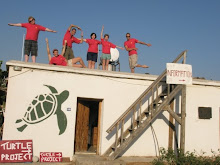The past few weeks have been crazy. The peak period of hatching with over 10 nests hatching at the same time for some days. We have four experiments currently underway at University of Exeter looking into population genetics and turtle behaviour. These all require a lot of man power on the beach at Alagadi night and day.
All of our nests (183 now as we had a very late loggerhead nest on Aug 30th...record year by 20 nests)are circled with a ring cage which forms a barrier around the nest on 40 days post lay. The ring cages have a gate which is closed just before dark. After dark each ring caged nest is checked every half an hour so the beaches are walked at these intervals through the night. On finding hatchlings in a ring cage they are put into a bucket and taken to our lab facility on Alagadi 1 beach where a biopsy sample is taken for genetic analysis. Some hatchlings are then used in time trial experiments to assess whether our work with them is having a detrimental effect on the energy levels of the hatchlings prior to release. Further, some hatchlings may be used in orientation experiments where individuals are released in a circular arena on the beach with artificial lights at the opposite side of the arena to the sea. We are experimenting to find which wavelengths (colours) of light attract hatchlings away from the sea most and which are turtle friendly. We may be able to find alternative lights that are visible to humans but not to hatchlings so getting around the problem of development on beaches where artificial lights cause hatchlings to travel away from the sea on hatching.
After nests have hatched and once a certain number of babies have emerged or if the nest has been hatching for a certain number of days, or if it has failed to hatch by 60 days, we then dig it up. If we think that some hatchlings may remain in the nest alive then we will call a public excavation as we have today. We usually have babies left from the previous night that we were unable to release before dawn, we can release these at sun set after the excavation with any live from the excavated nest. If the excavated nest is one of our study nests then the contents of the nest have to be taken back to the lab for biopsy. This is often a nasty job as many of the unhatched eggs can be very rotten and we need to take samples from any failed embryos. This PhD project is looking into the paternity of hatchlings....the contribution of males to the population. All of our studies have in the past focussed on females as these are the only individuals that come out of the water, but we are now using modern DNA technology to find out more about the population as a whole.
And all this is just at Alagadi, we still have 20 beaches around the rest of the island to survey every day carrying out excavations when we find hatched nests, averaging around 10 a day. Already short on numbers we had two volunteers that left a month early. At this point we had to close our base on the west coast and a group of two have been surveying the North and West coasts every other day. Hard work and a lot of driving and petrol.
Finally it looks like the storm has passed and things are beginning to calm down. We only have about 45 nests remaining on Alagadi (though in 2005 we had this many nests all season). It's a relief to walk down to the beach and not be confronted with a dense forest of white cages!
A few more volunteers on their way out though we are saying goodbye to more. Evren who has been volunteering arrives on Sunday and I'm looking forward to putting him to work. Mostly looking forward to the last few weeks of September when things really quieten down and hopefully there will be some time for a bit of recreation and maybe some tandem paragliding if the wind is right.
Meet at Alagadi tonight at 18:30 to see a public nest excavation and we also have about 50 hatchlings to release.
Robin
Friday, September 4, 2009
Subscribe to:
Post Comments (Atom)

No comments:
Post a Comment